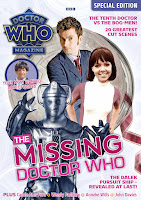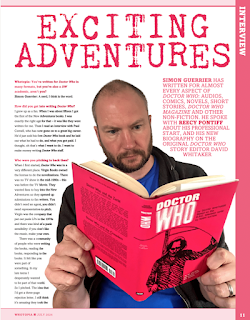“Informed public opinion is infectious, even to governments.” (p. 149)
Thursday, 30 July 1964 saw publication of two paperback “Penguin Specials” from Penguin Books both looking at the same subject. At four shillings, Nuclear Disaster by Tom Stonier,
Alongside this, at a slightly cheaper three shillings and sixpence, Margot Bennett’s The Intelligent Woman’s Guide to Atomic Radiation is, according to the back-cover blurb, a “first reader in the most uncomfortable subject in the world”.
The title is surely a riff on The Intelligent Woman’s Guide to Socialism and Capitalism by George Bernard Shaw, first published by Constable & Co in 1928 and republished in 1937 as an inexpensive two-volume paperback — the first Pelican Book — under the revised title The Intelligent Woman's Guide to Socialism, Capitalism, Sovietism & Fascism.
Of course, that was timely given the ongoing civil war between Republicans and Fascists in Spain, and the growing power of the Nazis in Germany. I’d be surprised if Margot Bennett wasn’t aware of the book, given that in 1937 she was in Spain. It was the year that Margot Mitchell (sometimes known as Margot Miller) married English journalist Richard Bennett while both were working for the Government — that is, Republican — radio station. Bennett, who also worked as a nurse, had been
machine-gunned in the legs the previous year and at the time of her engagement had recently
broken her arm when the ambulance she was in crashed under shellfire.
There’s nothing very militant in her book on atomic radiation, written 27 years later. “Politics is not the concern of this book,” she tells us in her introduction (p. 10). The focus is instead on the cause and effects fallout,
“addressed more to women than to men [because] the mother is far more intimately concerned with the health of the family than the father. It is the mother who sees that the children have green vegetables and milk, and who nurses then when they have measles.” (p. 11)
This still holds, she says, even if the mother has a career; a woman with no family, “still has a tenderness to children that is different in quality from the feelings of a man.”
It’s not exactly the most feminist stance but this is a politically active woman writing in the mid-1960s for a small-C conservative readership, the emphasis on presenting just the facts rather than on what we should think. The book concludes on a broad political note:
“Science affects us all; so far, overwhelmingly to our advantage. If there are times when we feel this is not so, as members of a democracy we have some kind of duty to find out what is happening.” (p. 154)
But there’s no sense of a particular party or ideology being favoured. We’re left to make up our own minds.
The domestic perspective — the way radiation affects milk and green vegetables, and our children — might imply this is rather lightweight or condescending to the ordinary housewife. Nothing could be further from the truth. Indeed one contemporary review thought it was,
“little more than another text book, and heavy going at that.” (Robin Turner, “Nuclear penguins and others”, Birmingham Post, 8 August 1964, p. 5.)
A more generous review found it,
“Thought provoking … easily read but thorough” (John Berrie, “Woman’s angle”, Nottingham Evening Post and News, 7 August 1964, p. 10.)
It’s certainly thorough, covering the ground in detail in just 154 pages (not including appendices, glossary and index). After the introduction, the first three chapters give us a grounding in the physics involved in atomic radiation — “Inside the Atom”, “Neutrons and Nuclear Energy" and “Fission, Fusion, and Fallout”. We then switch to biology for “The Message in Our Cells”.
Chapter 5, “The Subtle Enemy”, then applies the physics to the biology to explain the damage atomic radiation can do to us and to future generations. The next chapter, “The Influential Friend”, puts a counter case, outlining all the beneficial ways atomic radiation can be applied. “Pollution and Protection” addresses what can be done to mitigate potential fallout. Bennett then provides a conclusion, making the case that even statistically “negligible” numbers of people wounded or killed would still be tragic for those concerned.
A lot of this is very technical. Promotion for the book at the time said that Bennett wrote in “plain English” (for example, “For Your Bookshelf”, Halifax Daily Courier and Guardian, 31 July 1964, p. 4). Even so, I found it quite hard going and made slow progress.
Two things really bring it alive. First, Bennett peppers her book with vivid real-world examples of the way radiation can affect people’s lives. Hauntingly, she details the stages of radiation sickness suffered by early pioneers, from skin rashes and hair loss through anaemia, sterility and useless, deformed fingers to the fatal cancers (pp. 96-97). Or there’s the awful story of the
Radium Girls (pp. 100-101).
I’d be interested to know more about the Russian scientist who claimed to be able to cure the effects of radiation on DNA via a simple pill (p. 114), or about the Scottish boy discovered playing in a “pile of radioactive dust” and the factory making luminous dials that proved so radioactive that the Radiological Protection Service had the whole site buried (both stories p. 146). Frustratingly, there are no notes or bibliography to guide us to more information.
Secondly, throughout the book Bennett uses relatable, often domestic analogies to explain the complex ideas. She likens electrical charges — the way positive and negative attract one another but two positives or two negatives repel — to attraction between people, where a talker will fall for a listener (p. 17). She describes atoms of different elements as being like different breeds of dog (p. 22). Compounds and molecules are likened to marriages (p. 24).
Sometimes those analogies show how far we have come. On page 83, she refers to the cumulative effect of exposure to radiation over “the long days of our lives — 20,000 days if we live to be about sixty”, which doesn’t seem very long at all. (Bennett lived to 68).
But on the whole the effect is to make a complex, technical subject more tangible. The central, political idea here is the responsibility to be better informed: nuclear weapons are devastatingly powerful, but knowledge is also power — one to hold the arms race at bay.
*
Obligatory Doctor Who bit
Since the book was published at the end of July 1964, Bennett must have delivered the manuscript no later than, I’d guess, the end of May. Given the technical detail, it can’t have been a quick book to write. As well as the time taken to research it, a note just ahead of the introduction tells us that,
“Everything factual has been checked by scientists whose knowledge is far more than equal to the task” (p. 7).
We’re not told who these scientists were or what the editorial process involved, but writing and editing surely took some months, which means work on the book overlapped with Bennett’s conversation(s) with BBC story editor
David Whitaker about potentially writing for
Doctor Who. As detailed in
my post on Bennett’s novel The Furious Masters, that seems to have happened in late February 1964. She was being considered to write a story comprising four 25-minute episodes as a potential replacement for what became
Planet of Giants — but nothing further is known about what her story might have entailed, or whether she even submitted an idea.
I partly read this book in the faint hope of finding some clue as to what she might have discussed with or submitted to Whitaker. The short biography of Bennett on the opening page is suggestive:
“She likes variety in writing and is now doing something in Science Fiction,” (p. 1)
That “something” may have been The Furious Masters, published four years later. Or Bennett may have completed work on her study of atomic radiation and then turned to Doctor Who, only to discover that she was now too late and Planet of Giants was going ahead after all…
Then there’s one of the allusions she uses. At the end of her introduction, Bennett says that there’s no point wishing that the atom had never been cracked open.
“Man can’t afford to retreat; it is by discovery and invention, from fire and flint axe onwards, that he has survived. The axe is dangerously sharp, and the fire has grown as hot as the sun.” (p. 13)
Unlike most of the analogies she uses, this isn’t contemporary or domestic — it’s making a link between modern technology and the ancient past.
The first ever
Doctor Who story, broadcast 23 November to 14 December 1963, involves a tribe of cave people where authority is dependent on the ability to make fire (I think this owes a
debt to The Inheritors by William Golding). “Fire will kill us all in the end,” opines the Old Mother of the tribe.
In the next story, we see something of this prophecy come to pass when the TARDIS materialises in a petrified forest that Barbara initially thinks is the result of a “forest fire”. It turns out that the devastation is the result of a neutron bomb, leaving the ground and atmosphere “polluted with a very high level of fallout”. Beings called
Daleks are among the survivors.
I’m not the first to suggest that the Doctor Who production team deliberately juxtaposed the role of fire in the prehistoric tribe and the role of nuclear weapons on this futuristic world as part of a wider ambition to have the time travellers witness key moments of societal change. And it’s exactly the same connection made by Margot Bennett.
Did she and David Whitaker discuss it? And who exactly informed whom?






































